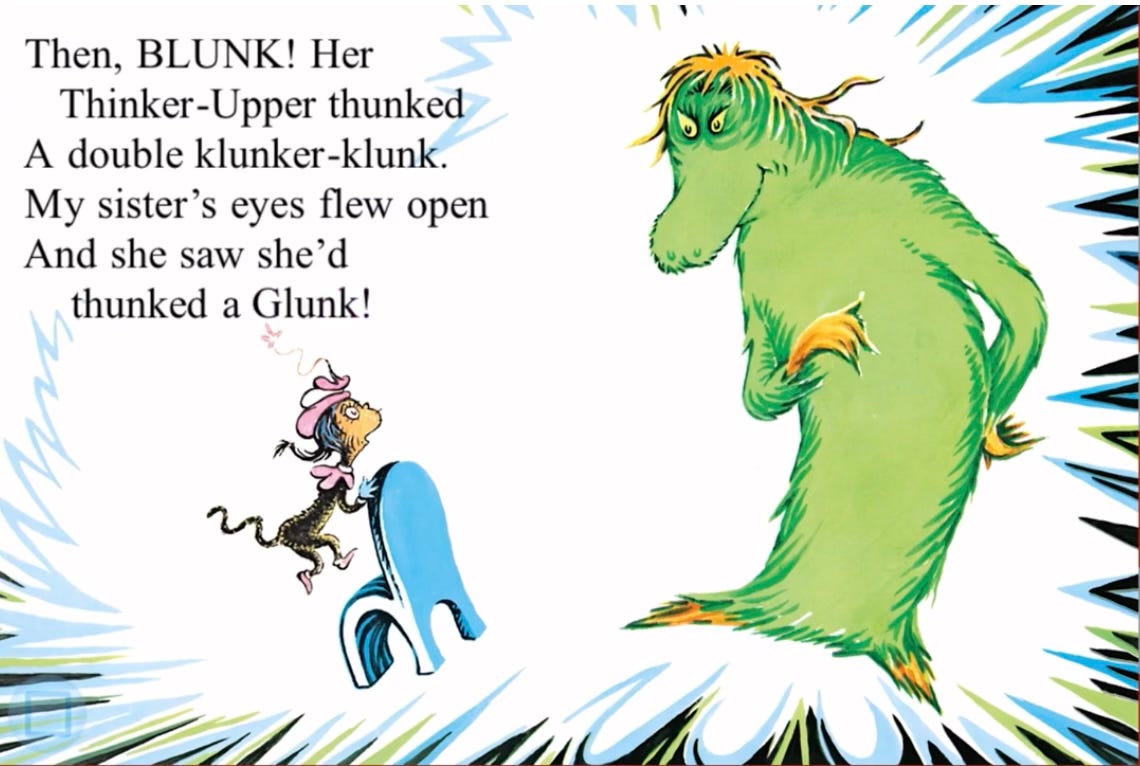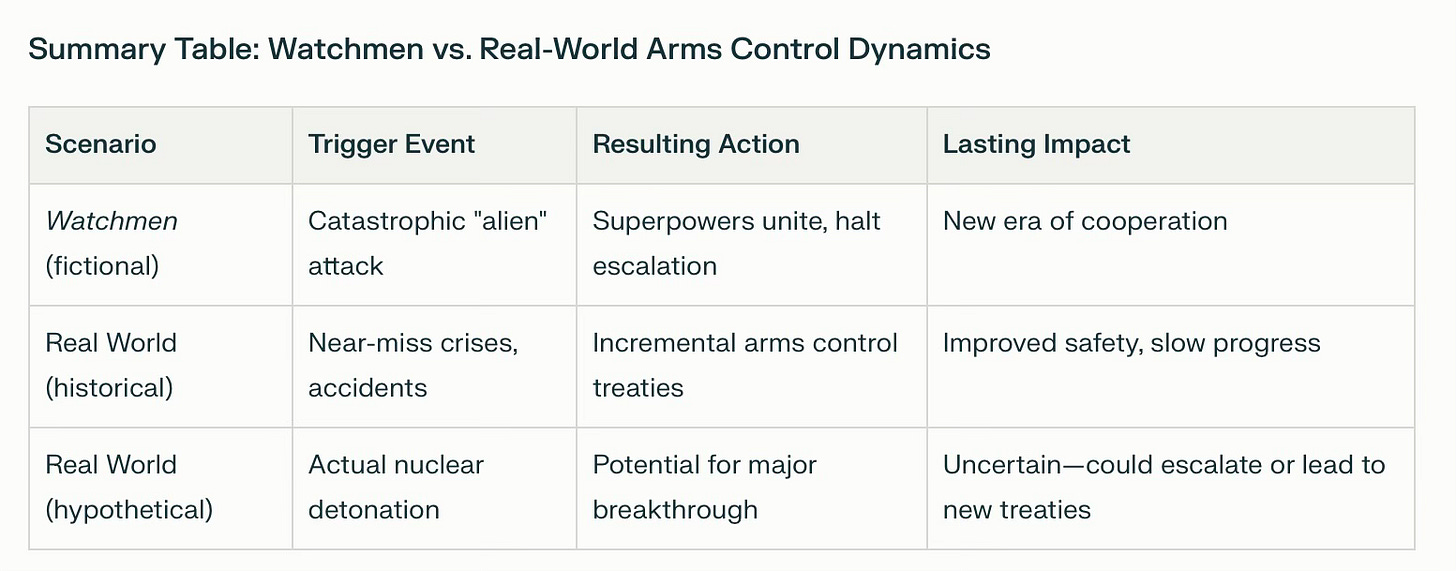[POST] The nuclear Thinker-Uppers have thunk again
The usual fear-mongering spread by nuclear arms-control types
This is a reader-supported publication. I give it all away for free but could really use your support if you want me to keep doing this.
There is this periodic effort made by the nuclear arms control universe to convince us all that we’re on the verge of Armageddon and that we’re living in the most dangerous moment yet in our shared nuclear-weapon history. Honestly, these mini-campaigns pop up with zero rhyme or reason.
A recent effort:
WAPO: WHY WE SHOULD WORRY ABOUT NUCLEAR WEAPONS AGAIN; The Cold War prospect of global annihilation has faded from consciousness, but the warheads remain.
The warheads remain … not a compelling lede.
We used to have a lot more of these warheads, as the article notes. Now, the world collectively has far fewer, but we are told there is so much more complexity in play now because there are nine nuclear powers!
First thing to keep in mind: we’ve had nine nuclear-scheming powers since the early 1970s — or for a half century. Of the nine nuclear powers today, the last to start their program was Pakistan in the early 1970s.
What have we seen since then? South Africa walked away (late 1980s), and, after the Soviet Bloc collapsed in the early 1990s, three former Soviet republics eventually surrendered their suddenly-inherited, previously-shared-by-Russia weapons — most infamously in the case of Ukraine. Oh, and Iran is an almost nuclear power, as it has been for quite some time to zero strategic effect.
What is the actual trajectory of successful proliferation?
From America’s New Map:
Following the first and only uses of nuclear weapons by the United States in 1945, six additional nuclear powers (the Union of Soviet Socialist Republics [USSR], United Kingdom [UK], France, China, Israel, and India) came into being over the next three decades. Since India joined the so-called nuclear club in 1974, there have been two new members reluctantly admitted: Pakistan (1990) and North Korea (2006). That record describes a profound slowing of nuclear proliferation over eight decades—from one power every four years to one every twenty. Despite those persistently scary predictions, we remain stuck in the single digits at nine club members.
It is not hard to see how experts generate their predictions of “dozens” of new nuclear powers. The North Atlantic Treaty Organization (NATO)’s sharing of nuclear weapons (i.e., stationing of US nuclear weapons within allies’ territory) presently involves five states (Belgium, Germany, Italy, Netherlands, and Turkey). Then there are the dozen-and-a-half states that have given up their nuclear weapons and/or programs—shared or not. Finally, there are those states whose nascent nuclear capacities were destroyed by Israel in preemptive attacks (Iraq, Syria, and someday possibly Iran). Add that all up and you have three dozen states with some nuclear weapons history. However, for every state that joined the nuclear club, three walked, or were escorted, away.
What does that anything-but-uncontrollable dynamic tell us?
Nuclear arsenals only make sense for certain great powers—namely, those in antagonistic rivalries with other great powers capable of large-scale conventional and nuclear warfare. So, once America invented nukes, the Soviet Union needed them in reply. That pushed France and the UK to counter the USSR within Europe. China needed nukes against both the United States and the Soviets. Israel needed them to protect itself against the combined forces of the Arab world. India needed them against both China and its archenemy, Pakistan. Pakistan followed suit vis-à-vis India. Finally, North Korea made the reach out of fear of US-backed South Korea’s significant military capability—and our nuclear arsenal.
There is your history of “out of control” proliferation, which has resulted in zero strategic wars among that constellation of powers once their individual nuclear status was achieved and recognized by the rest.
There’s your history: two new nuclear powers in the last half century. Not exactly a blistering pace and almost two full decades since the last new power was recognized (North Korea).
The calculations offered in the WAPO basically match up with the totals I offered in America’s New Map, where I noted that China was mostly definitely adding new warheads. But even if you go with that 600 total cited by WAPO, we’re still talking one-sixth the US total and one-seventh the Russian total. So, again, we’re not talking about some profound rebalancing.
Amidst this evolving situation, what has happened in the real world to justify heightened fears of nuclear exchanges?
Again, from ANM:
In the meantime, both the Soviet Bloc and the USSR collapsed without nuclear war, China rose peacefully, and India now does the same. Europe has had two wars (Balkans, Russia-v-Ukraine), but neither went nuclear. India and Pakistan still spar to no effect. In the Middle East, a nuclear Iran likely someday faces off against Israel and a suddenly nuclear Saudi Arabia in a dangerous but familiar strategic standoff. Or the nascent Saudi-Israeli-Emirati alliance will succeed in permanently postponing that scenario.
There will always remain the danger that one nuclear power will, in a moment of desperation or confusion, press the nuclear button. But the world’s superpowers have managed that reality for decades now through all manner of proxy wars, standoffs, and the like. It is not a foolproof system by any means, yet the total lack of all-out, direct conventional or strategic warfare among nuclear powers for almost eight decades is an amazingly stable record—so much so that it is hard to imagine having achieved that situation without nuclear weapons. As Faustian bargains go, this one is totally worth it.
Admittedly, I am a glass-half-full guy on this subject.
So, let’s examine the “new” case being offered in this — by my estimation — alarmist WAPO article:
Over the past 30 years, since the collapse of the Soviet Union, the prospect of nuclear war has faded from the American consciousness. With the end of the Cold War, films depicting the last days of humanity, such as 1959’s “On the Beach,” or the 1983 TV drama “The Day After,” largely disappeared from the Hollywood playbook. Schoolchildren no longer hid under their desks during practice drills to survive nuclear war.
But the weapons never went away. While thousands were scrapped and nuclear inventories were significantly reduced, many other weapons were put into storage and still thousands more remain deployed, ready for use.
Now, they and the dangers they pose are making a comeback.
Okay, a “comeback.”
But where?
Today’s global nuclear landscape is far more complicated and, in many ways, more precarious. More countries and more advanced technologies are involved. Weapons can fly farther, faster, from more places. Information, accurate or false, can move even more quickly. Autocrats and extremists hold positions of power in nuclear-armed countries. Nuclear threats, once taboo, are now increasingly common. And the last nuclear arms control treaty still in force between Russia and the United States expires in February.
So, conventional strike capabilities have advanced, like they always do. None of those developments say nuclear weapons are now more useable or that mutually-assured destruction is now invalidated. Indeed, the rising capabilities of conventional arms and missiles are equally suggestive of the notion that nuclear weapons aren’t needed to do one’s strategic business.
As for changes in leadership in these nuclear-armed countries, I’m just not seeing the qualitative change. Modi is scarier than Indira Gandhi was? Not buying it. The latest Kim in NorKo is qualitatively different from preceding versions? Not seeing it. Pakistan worse off now in terms of leadership than previously? Don’t agree. Israel more aggressive or unhinged today than in the past? Nope. China scarier with Xi than with bring-it-one Mao? Definitely not the case. Russia still run by the security sector? Yup. No changes in US, France, or UK worth mentioning.
Nuclear threats now less taboo than in the past? By my calculation, that’s a complete bullshit reading of history. In fact, I would argue the opposite: never have nuclear threats rung more hollow. I mean, I’m watching Ukraine popping Putin in the face over and over again and the Kremlin’s vague rumblings about dishing it out strike me as completely weak-ass. If anything, Ukraine is showing how pointless nukes are when a nuclear power engages in conventional war with a non-nuclear power.
As for the imminent demise of the “last nuclear arms control treaty still in force” … now we finally get to the crux of these nuclear arms-control types’ argument, which is basically, bring back nuclear arms control!
Good idea?
Always a good idea.
Somehow more desperately needed today than in recent years?
Hmm. We’ll get to that …
What we do have, amidst the decaying of old arsenals and the supremely large sums of money that Russia and the US would need to spend to update and modernize old warheads, is the usual toying by military leaders (primarily in the US, as usual) with the idea of limited nuclear strikes.
From the WAPO piece:
Many of the most dangerous ideas from the Cold War are being resurrected: lower-yield weapons to fight “limited” nuclear wars; blockbuster missiles that could destroy multiple targets at once; the redeploying of a whole class of missiles once banned and destroyed by treaty. On top of this, countries are testing new ways to deliver these weapons, including nuclear-powered cruise missiles that can fly for days before hitting their targets; underwater unmanned nuclear torpedoes; fast-flying, maneuverable glide vehicles that can evade defenses; and nuclear weapons in space that can attack satellites or targets on Earth without warning.
All nifty stuff to consider but none of it changes the logic of MAD — as in, if you go nuclear on me, then I’m going nuclear on you.
Can I imagine China taking down Taiwan and the US and China shooting it up big-time for a period without going to nukes?
Yes, yes I can — particularly after Ukraine. I can foresee one giant “drone hellscape” that essentially goes nowhere but is one helluva show.
Regardless, has that problem-set been around for a while? Uh … by some calculations it’s been around since the Eisenhower Administration. So, yeah, everything’s faster and more pin-pointy today, but — again — how does that offer anyone the ability to wage nuclear war successfully against other nuclear states?
The WAPO piece doesn’t lay out scenarios for successful nuclear wars, because they aren’t any.
Instead, we're fed some dribble about heightened complexity in a truly brain-dead argument.
First, we are told that “the nuclear threat has roared back to life.”
Then we are reminded of how much things have changed …
“At this moment in human history,” the Nobel Committee said in announcing last year’s Peace Prize, “it is worth reminding ourselves what nuclear weapons are the most destructive weapons the world has ever seen.” The prize went to Nihon Hidankyo, an association of survivors of the U.S. bombings of Hiroshima and Nagasaki in 1945 — the only time nuclear weapons have ever been used in wartime.
So, the Nobel Committee awards the peace prize to an association of survivors from the only nuclear strikes ever unleashed … 80 years ago.
Compelling logic.
It gets worse:
Nuclear analysts like to refer to the U.S.-Russia-China nuclear dynamic as the three-body problem. This stems from the classic physics phenomenon: the gravitational interaction between three objects is exponentially more difficult to predict than between two. Even if the U.S. and Russia could again agree to limit their nuclear forces, the growth of China’s capabilities could drive them both to pursue more weapons, throwing any limits into doubt.
First off, citing classic physics problems as a model for nuclear war is just plain stupid. I could cite the Holy Trinity and it would make just about as much sense.
Neither Russia nor the US can afford to modernize their respective aging nuclear arsenals as it is. They will, of course, but it will be supremely expensive and likely feature further numerical diminishment. As for “pursuing more weapons,” China’s expansion from low-hundreds to mid-hundreds isn’t even close to a moving-the-needle shift on either state’s calculations.
Oh, and by the way, we’ve lived with this scary “three-body problem” for how long now? Since 1964? Sounds like 60 years to me. Why weren’t we informed about this terrifying three-body bit until now?
Ah, but that’s the thing. Now, we have a nine-body problem!!!
But this is not just a three-body problem; it’s a nine-body problem, and it defies simple explanation or solutions.
So, a completely inappropriate model now applied to a pool of actors three times larger — mind-blowing!!!
Again, the scary developments cited do not impress: for example, Trump’s Golden Dome won’t be any more real than Reagan’s Star Wars was.
But, we digress …
AI is going to kill us all.
Okay, I’ll bite on that one. Nuclear powers are going to surrender control over launches to AI because … MAD no longer applies? Please run me through that new “reality.”
No one knows how this new technology will ultimately affect nuclear strategy.
I do. It won’t change MAD, but, yeah, it will increase the possibility of accidental launches for any power stupid enough to automate their launch sequences and make AI the decider-in-chief. Is anybody dumb enough to do that?
A legit question.
Finally, we get to the scary new logic/reality to be presented here:
This diagram depicts the scary Cold War stand-off. Let’s just say that UK and France counted for … pretty much nothing in this calculation. MAD worked. There was no nuclear Armageddon. And yeah, the standoff continues in some form to this day.
Next!
Ah, India and Pakistan could mix it up — the classic two-body problem. We are 35 years and counting on that one, interrupted regularly by performative strikes across the border. I’m not seeing any big change or evolution on that one. Instead, I see two nuclear powers that have avoided full-scale war since MAD was achieved.
What else you got?
Ah … China!
It could get it on with North Korea.
I would actually welcome that one, as would much of the world.
China could get it on with India, like they did on their border 63 years ago.
Not holding my breath.
China gets it on with Russia?
Play me the scenario.
I’m waiting …
China gets it on with the US over Taiwan? Exactly how long have we suffered that unbearable risk? Ah … again … six-to-seven decades, depending how you want to categorize things. Let’s just call it a half-century and leave it at that.
Can we pose some five-body problem with China? You know, the one where North Korea, Russia, India, and the US agree to strike China simultaneously?
Let me ponder that one a bit.
Done. Not buying.
Sorry to say. I’m not seeing even your three-body problem anywhere among our nine. You can claim it exists but I still cry bullshit. Instead, I spot the same two-body standoff in a number of bilateral situations — none of which present winnable nuclear-war scenarios and thus do not invalidate MAD.
The rest of the piece offers the usual fears obsessed over by this crowd: irrational actors, enough bombs to collectively trigger a nuclear winter, miscalculations and false alarms — none of it new unless, again, we have a nuclear power SO CONFIDENT in AI that it somehow turns the entire show over to a reasoning engine known to hallucinate on a regular basis.
Time to rewatch Doctor Strangelove alright, but, again, not enough to keep me up at night.
Honestly, the best thing that could happen to this situation is for somebody to blow one off accidentally or purposefully so the entire world could suddenly be mobilized for some big breakthrough on arms control.
I know, so Watchmen.
Where is our Ozymandias on that one?
Let me ask Perplexity:
That crucible possibility will always hang out there, but, no, even that doesn’t disturb my sleep.
I have grown to despise fear mongering in general and nuclear fear-mongering in particular.
Nukes remain what they have always been: useful only in deterring nuclear attacks by other nuclear powers, with the subset rule being two nuclear powers don’t mix it up comprehensively and directly over anything because it’s just not worth it.
Russia-Ukraine introduces a certain wrinkle here, to be sure, but it’s not a particularly new or compelling one. Instead, it just says that nuclear powers can invade any non-nuclear power they want — and that even that will not trigger nuclear escalation, no matter how nasty it gets.
America re-invented that rule-set decades ago. I say, “reinvented” because great powers have been doing this throughout history, just with far more discretion in our nuclear age.
If America can topple non-nuclear regimes really anywhere it cares to, then Russia gets to do the same with neighboring Ukraine and China has the same outstanding opportunity with Taiwan.
That’s a realistic take on a multipolar world, but it’s got nothing to do with invalidating MAD or triggering some imagined new nuclear age.
It just doesn’t.















